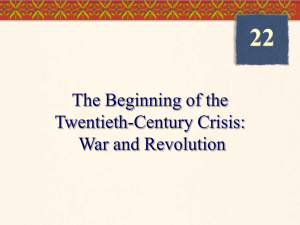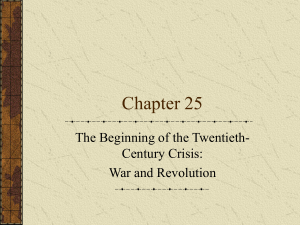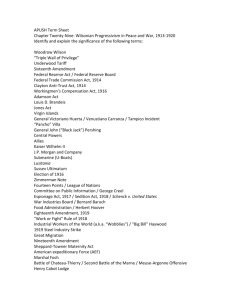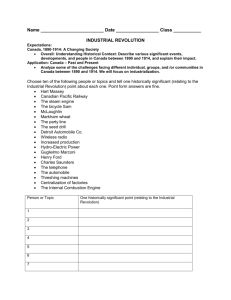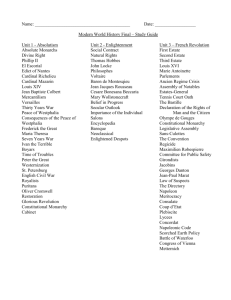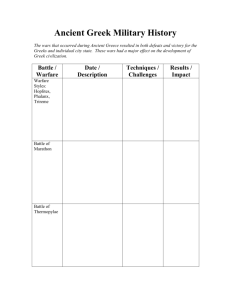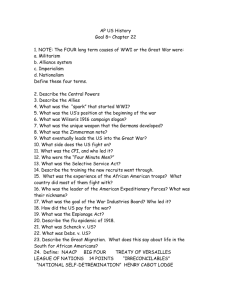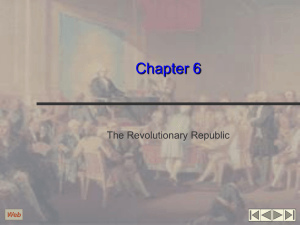Chapter 25
advertisement
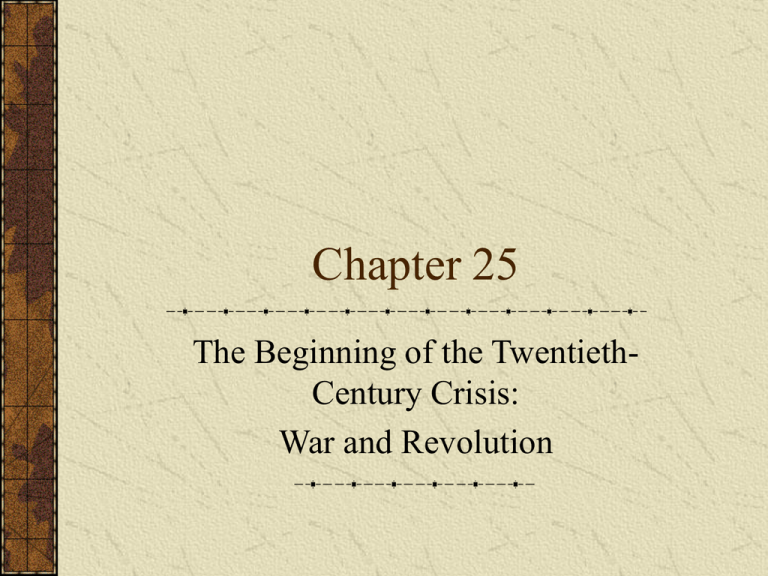
Chapter 25 The Beginning of the TwentiethCentury Crisis: War and Revolution ©2003 Wadsworth, a division of Thomson Learning, Inc. Thomson Learning™ is a trademark used herein under license. Europe in 1914 The Road to World War I Nationalism and Internal Dissent Nationalism • Diplomacy based on national states to bring peace • Led to competition instead of cooperation Socialist labor movements create fear Militarism Conscription Influence of military leaders The Outbreak of War: The Summer of 1914 The effects of the Balkan Wars prior to 1914 Assassination of Archduke Francis Ferdinand and wife Sophia, June 28, 1914 German “full support” to Austria Russian mobilization Schlieffen Plan ©2003 Wadsworth, a division of Thomson Learning, Inc. Thomson Learning™ is a trademark used herein under license. The Schlieffen Plan The War 1914-195: Illusions & Stalemate European attitudes toward the beginning of war Failure of the Schlieffen Plan First Battle of the Marne, September 6-10, 1914 Russian failures Battle of Tannenberg, August 30, 1914 Battle of Masurian Lakes, September 15, 1914 Austrian failures Galicia and Serbia Germans come to Austria’s aid Battle Scene in Northern France The War 1916-1917: The Great Slaughter Trench warfare “No-man’s land” “Softening up” the enemy Battle of Verdun, 70,000 lost Battle of the Somme, 1916 • Heaviest one-day loss in WWI Trench Warfare in France ©2003 Wadsworth, a division of Thomson Learning, Inc. Thomson Learning™ is a trademark used herein under license. The Western Front, 1914-1918 The Eastern Front, 19141918 The Widening of the War Ottoman Empire enters the war Battle of Gallipoli, April 1915 Italy enters the war, May 1915, against Austria-Hungary Bulgaria enters the war, September 1915, on the side of the Central Powers Middle East Lawrence of Arabia (1888-1935) Entry of the United States The United States tried to remain neutral Sinking of the Lusitania, May 7, 1915 Return to unrestricted submarine warfare January 1917 United States enters the war, April 6, 1917 Bolshevik Revolution, 1917 A New Kind of Warfare New Technology Airplanes Machine Guns Zeppelins Tanks The Home Front: The Impact of Total War Governments become more centralized Conscription Effects on Economics Public order and public opinion Dealing with unrest Defense of the Real Act Propaganda Social Impact of Total War Labor benefits New roles for women • Male concern over wages • Women began to demand equal pay • Gains for women War and Revolution: Russia The Russian Revolution • Nicholas II was an autocratic ruler • Russia not prepared for war • Influence of Rasputin The March Revolution • • • • • Problems in Petrograd March of the women, March 8, 1917 Calls for a general strike Soldiers join the marchers Provisional Government takes control Alexander Kerensky (1881-1970) Tried to carry on the war Soviets sprang up Bolshviks the most important Russian Revolutions The Bolshevik Revolution Under the leadership of Vladimir Ulianov, 1870-1924 • Sent back to Russia in a sealed train by the Germans • “Peace, land and bread” Bolsheviks control Petrograd and Moscow soviets Collapse of Provisional Government, November 6-7, 1917 Treaty of Brest-Litovsk, March 3, 1918 Civil war Bolshevik (Red) army and Anti-Bolshevik (White) army Red Terror by the Cheka Allied invasion Differences among the white army Communists and “War communism” Invasion of allied troops Communists will control Russia The Last Year of the War Last German offensive, March 21-July 18, 1918 Allied counterattack, Second Battle of the Marne, July 18, 1918 General Ludendorff informs German Leaders that the war is lost William II abdicates, November 9, 1918 Republic established Armistice, November 11, 1918 The Peace Settlement Palace of Versailles, January 1919, 27 Allied nations Woodrow Wilson, Fourteen Points Pragmatism of other states Lloyd George determined to make Germany pay Georges Clemenceau of France concerned with his nation’s security January 25, 1919, the principle of the League of Nations adopted The Treaty of Versailles Five separate treaties (Germany, Austria, Hungary, Bulgaria, and the Ottoman Empire) The most important was the Treaty of Versailles, June 18, 1919 Article 231, War Guilt Clause 100,000 man army Loss of Alsace and Lorraine Sections of Prussia to the new Polish state German charges of a “dictated peace” The Other Peace Treaties German and Russian Empires lost territory in eastern Europe New nation-states: Finland, Latvia, Estonia, Lithuania, Poland, Czechoslovakia, Austria, and Hungary Romania acquired additional lands from Russia, Hungary, and Bulgaria Yugoslavia Compromises will lead to future problems Minorities in every eastern European states Ottoman Empire dismembered Promises of independence of Arab states in the Middle East Mandates • France – Lebanon and Syria • Britain – Iraq and Palestine United States Senate rejects the Versailles Peace Treaty ©2003 Wadsworth, a division of Thomson Learning, Inc. Thomson Learning™ is a trademark used herein under license. Europe in 1919 ©2003 Wadsworth, a division of Thomson Learning, Inc. Thomson Learning ™ is a trademark used herein under license. The Middle East in 1919 Discussion Questions Describe what you might think were the effects of the industrial revolution on the fighting in World War I. How did the industrial revolution help to create the trench warfare? What was the effect of the entry of the United States into World War I. What were the changes on the map of Europe as a result of World War I? Web Links Archduke Francis Ferdinand Trench Warfare American Expeditionary Force Bolshevik Revolution Vladimir Ilyich Lenin Treaty of Versailles
